
Strontianite (SrCO3) is an important raw material for the extraction of strontium. It is a rare carbonate mineral and one of only a few strontium minerals. It is a member of the aragonite group.

Tephroite is the manganese endmember of the olivine group of nesosilicate minerals with the formula Mn2SiO4. A solid solution series exists between tephroite and its analogues, the group endmembers fayalite and forsterite. Divalent iron or magnesium may readily replace manganese in the olivine crystal structure.

Clinohumite is an uncommon member of the humite group, a magnesium silicate according to the chemical formula (Mg, Fe)9(SiO4)4(F,OH)2. The formula can be thought of as four olivine (Mg2SiO4), plus one brucite (Mg(OH)2). Indeed, the mineral is essentially a hydrated olivine and occurs in altered ultramafic rocks and carbonatites. Most commonly found as tiny indistinct grains, large euhedral clinohumite crystals are sought by collectors and occasionally fashioned into bright, yellow-orange gemstones. Only two sources of gem-quality material are known: the Pamir Mountains of Tajikistan, and the Taymyr region of northern Siberia. It is one of two humite group minerals that have been cut into gems, the other being the much more common chondrodite.
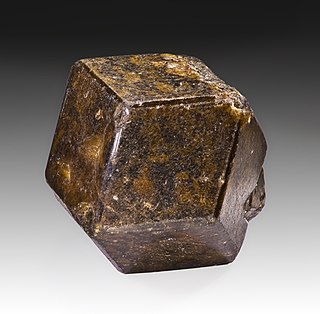
Andradite is a mineral species of the garnet group. It is a nesosilicate, with formula Ca3Fe2Si3O12.

Ajoite is a hydrated sodium potassium copper aluminium silicate hydroxide mineral. Ajoite has the chemical formula (Na,K)Cu7AlSi9O24(OH)6·3H2O, and minor Mn, Fe and Ca are usually also present in the structure. Ajoite is used as a minor ore of copper.
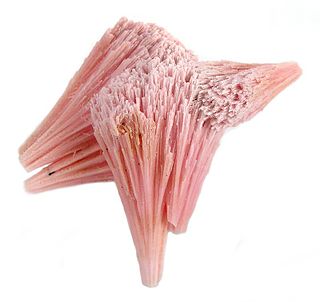
Kutnohorite is a rare calcium manganese carbonate mineral with magnesium and iron that is a member of the dolomite group. It forms a series with dolomite, and with ankerite. The end member formula is CaMn2+(CO3)2, but Mg2+ and Fe2+ commonly substitute for Mn2+, with the manganese content varying from 38% to 84%, so the formula Ca(Mn2+,Mg,Fe2+)(CO3)2 better represents the species. It was named by Professor Bukowsky in 1901 after the type locality of Kutná Hora, Bohemia, in the Czech Republic. It was originally spelt "kutnahorite" but "kutnohorite" is the current IMA-approved spelling.

Pabstite is a barium tin titanium silicate mineral that is found in contact metamorphosed limestone. It belongs to the benitoite group of minerals. The chemical formula of pabstite is Ba(Sn,Ti)Si3O9. It is found in Santa Cruz, California. The crystal system of the mineral is hexagonal.
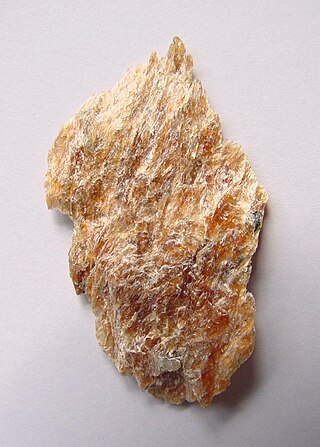
Yuksporite is a rare inosilicate mineral with double width, unbranched chains, and the complicated chemical formula K4(Ca,Na)14Sr2Mn(Ti,Nb)4(O,OH)4(Si6O17)2(Si2O7)3(H2O,OH)3. It contains the relatively rare elements strontium, titanium and niobium, as well as the commoner metallic elements potassium, calcium, sodium and manganese. As with all silicates, it contains groups of linked silicon and oxygen atoms, as well as some associated water molecules.

Tobermorite is a calcium silicate hydrate mineral with chemical formula: Ca5Si6O16(OH)2·4H2O or Ca5Si6(O,OH)18·5H2O.
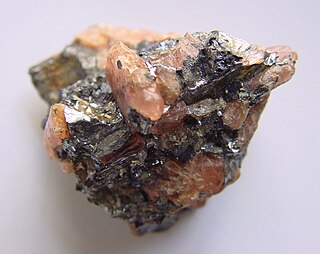
Bustamite is a calcium manganese inosilicate (chain silicate) and a member of the wollastonite group. Magnesium, zinc and iron are common impurities substituting for manganese. Bustamite is the high-temperature polymorph of CaMnSi2O6 and johannsenite is the low temperature polymorph. The inversion takes place at 830 °C (1,530 °F), but may be very slow.
Bustamite could be confused with light-colored rhodonite or pyroxmangite, but both these minerals are biaxial (+) whereas bustamite is biaxial (-).
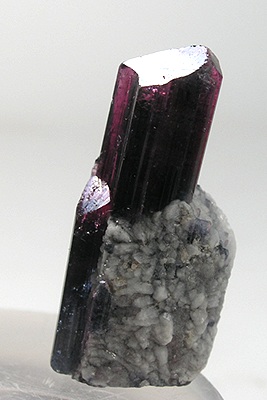
Fluor-liddicoatite is a rare member of the tourmaline group of minerals, elbaite subgroup, and the theoretical calcium endmember of the elbaite-fluor-liddicoatite series; the pure end-member has not yet been found in nature. Fluor-liddicoatite is indistinguishable from elbaite by X-ray diffraction techniques. It forms a series with elbaite and probably also with olenite. Liddiocoatite is currently a non-approved mineral name, but Aurisicchio et al. (1999) and Breaks et al. (2008) found OH-dominant species. Formulae are
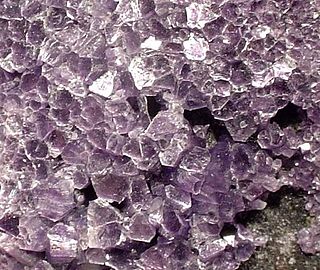
Amesite is a mineral with general formula of Mg2Al2SiO5(OH)4.

Vlasovite is a rare inosilicate (chain silicate) mineral with sodium and zirconium, with the chemical formula Na2ZrSi4O11. It was discovered in 1961 at Vavnbed Mountain in the Lovozero Massif, in the Northern Region of Russia. The researchers who first identified it, R P Tikhonenkova and M E Kazakova, named it for Kuzma Aleksevich Vlasov (1905–1964), a Russian mineralogist and geochemist who studied the Lovozero massif, and who was the founder of the Institute of Mineralogy, Geochemistry, and Crystal Chemistry of Rare Elements, Moscow, Russia.

Tsumcorite is a rare hydrated lead arsenate mineral that was discovered in 1971, and reported by Geier, Kautz and Muller. It was named after the TSUMeb CORporation mine at Tsumeb, in Namibia, in recognition of the Corporation's support for mineralogical investigations of the orebody at its Mineral Research Laboratory.

Whiteite is a rare hydrated hydroxyphosphate mineral.
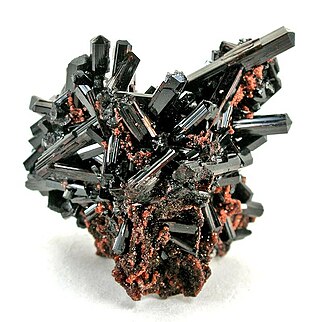
Manganvesuvianite is a rare mineral with formula Ca19Mn3+(Al,Mn3+,Fe3+)10(Mg,Mn2+)2(Si2O7)4(SiO4)10O(OH)9. The mineral is red to nearly black in color. Discovered in South Africa and described in 2002, it was so named for the prevalence of manganese in its composition and its relation to vesuvianite.
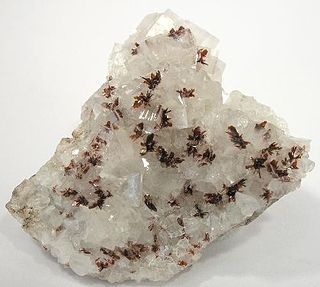
Ruizite is a sorosilicate mineral with formula Ca2Mn2Si4O11(OH)4·2H2O. It was discovered at the Christmas mine in Christmas, Arizona, and described in 1977. The mineral is named for discoverer Joe Ana Ruiz.

Tumchaite, Na2(Zr,Sn)Si4O11·H2O, is a colorless to white monoclinic phyllosilicate mineral. It is associated with calcite, dolomite, and pyrite in the late dolomite-calcite carbonatites. It can be transparent to translucent; has a vitreous luster; and has perfect cleavage on {100}. Its hardness is 4.5, between fluorite and apatite. Tumchaite is isotypic with penkvilksite. The structure of the mineral is identified by silicate sheets parallel {100}, formed by alternation of clockwise and counterclockwise growing spiral chains of corner-sharing SiO4 tetrahedra. Tumchaite is named for the river Tumcha near Vuoriyarvi massif.
Balliranoite ((Na,K)6Ca2(Si6Al6O24)Cl2(CO)3) is a mineral that was discovered at Monte Somma – Vesuvio volcanic complex, Campania, Italy. This mineral is named in honor of Paolo Ballirano (b. 1964), Italian crystallographer and professor in the Department of Earth Sciences, University of Rome ‘‘La Sapienza’’, who has made important contributions to the crystal chemistry of cancrinite-group minerals.


















